Abstract:
With the increasing demands for signal transmission rates or resolution in fields such as wireless communication, radar, satellite communication, and optical communication, the modulation schemes used have become increasingly complex, and the signal bandwidth has widened. Modern real-time oscilloscopes, due to advancements in chip and material technology, can now provide real-time measurement bandwidths of up to several tens of GHz. Additionally, due to their intuitive time-domain measurements and multi-channel capabilities, they are now widely used for ultra-wideband and RF signal measurements. This article introduces typical applications of high-bandwidth real-time oscilloscopes in the field of RF signal measurement, as well as key indicators such as noise floor, spurious-free dynamic range, harmonic distortion, absolute amplitude measurement accuracy, and phase noise when using oscilloscopes for RF measurements.
Introduction:
Every engineer involved in RF or high-speed digital design faces the challenge of both frequency domain and time domain testing. For instance, engineers engaged in high-speed digital circuit design typically analyze signal waveforms and eye diagrams in the time domain, while also using frequency domain S-parameters to analyze insertion loss in transmission channels or phase noise metrics to analyze clock jitter. For the analysis of wireless communication, radar, and navigation signals, traditional frequency domain tests such as spectrum, spurious, and adjacent channel suppression are required. However, with the increasing bandwidth of signals and the application of pulse modulation and frequency hopping technologies, time-domain measurement methods can sometimes be more effective.
The performance of modern real-time oscilloscopes has significantly improved compared to over a decade ago, meeting the testing requirements for high bandwidth and high precision RF microwave signals. Furthermore, the triggering and analysis functions of modern real-time oscilloscopes have become richer, the user interface more user-friendly, data transfer rates higher, and multi-channel support capabilities better, allowing high-bandwidth real-time oscilloscopes to play an important role in broadband signal testing.
1. Why Use an Oscilloscope for RF Signal Testing?
Intuitive Time-Domain Measurement
One major reason for conducting time-domain measurements of RF signals is their intuitiveness. For example, the figure below shows four different shapes of radar pulse signals, where the carrier frequency and pulse width are similar. If only frequency domain analysis is performed, it is difficult to infer the time-domain shape of the signals. The different shapes of these four time-domain pulses are crucial for the final convolution processing algorithms and system performance, necessitating precise measurement of the pulse parameters in the time domain to ensure they meet system design requirements.
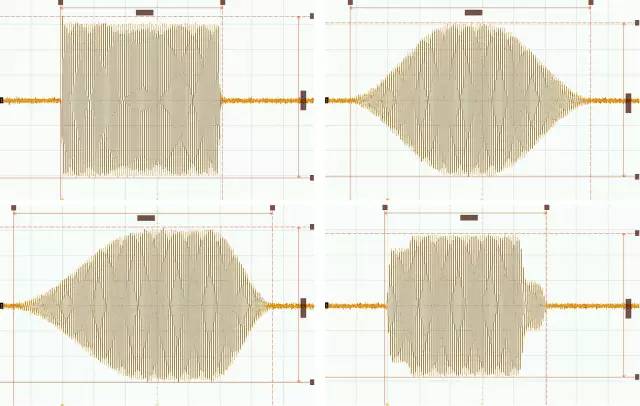
Higher Analysis Bandwidth Requirements
In traditional RF microwave testing, oscilloscopes with lower bandwidths (<1GHz) are often used for time-domain parameter testing, such as using detectors to extract the envelope of RF signals for parameter testing or capturing signals after down-conversion. At this point, the RF signal has already been filtered out or converted to an intermediate frequency, so the bandwidth requirements for the oscilloscope used for measurement are not high.
However, with the development of communication technology, the modulation bandwidth of signals has increased. For example, to balance power and distance resolution, modern radars use frequency or phase modulation within the pulse, with typical SAR imaging radar modulation bandwidths potentially exceeding 2GHz. In satellite communications, to miniaturize and increase transmission rates, the crowded C band and Ku band are avoided in favor of the Ka band, which offers higher spectral efficiency and available bandwidth, with actual usable modulation bandwidths reaching over 3GHz or even higher. Additionally, the amplitude-frequency characteristic curve of oscilloscopes is not flat from DC to rated bandwidth; it begins to decline significantly after reaching a certain frequency point. Therefore, when selecting a real-time oscilloscope, its bandwidth should exceed the required analysis bandwidth, and the extent to which it exceeds should be based on the oscilloscope’s actual frequency response curve and the requirements of the signal being measured.
At such high transmission bandwidths, traditional measurement methods using detectors or down-conversion face significant challenges. It is difficult to find a detector or down-converter on the market that can achieve bandwidths exceeding 2GHz while also having ideal amplitude-frequency/phase-frequency characteristics, leading to serious distortion in test results.
Moreover, if demodulation of the internal modulation information of radar pulses or satellite communication signals is required, very high real-time bandwidth is also necessary. Traditional spectrum analyzers have high measurement accuracy and frequency range, but their real-time analysis bandwidth currently does not reach above GHz. Therefore, for the analysis and demodulation of broadband signals above GHz, the most commonly used method is to utilize broadband oscilloscopes or high-speed data acquisition systems.
2. Development of Modern Real-Time Oscilloscope Technology
Traditional oscilloscopes, due to their lower bandwidth, cannot directly capture high-frequency RF signals, so their application in the RF microwave field is limited to intermediate frequency or control signal testing. However, with advancements in chip, material, and packaging technologies, the bandwidth, sampling rate, storage depth, as well as noise floor, jitter, and other performance indicators of modern real-time oscilloscopes have significantly improved.
Material Technology Innovations Enhancing Oscilloscope Bandwidth
For example, indium phosphide (InP) has become a popular material in recent years both internationally and domestically. Compared to traditional SiGe or GaAs materials, InP offers better electrical performance, providing higher saturation electron velocity, lower surface recombination velocity, and higher electrical insulation strength. However, the adoption of new materials also requires addressing a series of process issues. For instance, while InP has excellent high-frequency characteristics, using traditional aluminum substrates can lead to issues with inconsistent thermal expansion coefficients and heat dissipation efficiency. Aluminum nitride (AlN) is a new ceramic substrate material that has thermal properties closer to InP and better heat dissipation characteristics, but AlN is costly and hard, requiring laser etching for processing.
With the application of new materials and technologies, the hardware bandwidth of modern real-time oscilloscopes has reached over 60GHz, and due to the excellent characteristics of indium phosphide (InP), the frequency response of oscilloscopes has become flatter, the noise floor lower, and the lower power consumption has increased product reliability.
In addition to providing excellent high-bandwidth performance, InP also has a higher reverse breakdown voltage, allowing oscilloscopes designed with InP to have an input range of up to 8V, equivalent to over 20dBm, greatly enhancing practicality and reliability.
ADC Sampling Technology Enhancing Oscilloscope Sampling Rate
To ensure high real-time bandwidth, according to Nyquist’s theorem, the sampling rate of the ADC following the amplifier must be at least twice the bandwidth (engineering implementations typically ensure over 2.5 times). Currently, there are no single-chip ADCs on the market that can achieve such high sampling rates, so high-bandwidth real-time oscilloscopes usually employ ADC stitching technology.
There are two typical methods for ADC stitching: one is on-chip stitching, and the other is off-chip stitching. On-chip stitching integrates multiple ADC cores within a single chip, as exemplified by the Keysight S series oscilloscopes, which use a 40G/s sampling rate 10-bit ADC chip, achieving 10-bit resolution within an 8GHz bandwidth for the first time in the industry. The advantage of on-chip stitching is that consistency and delay control between channels can be managed very well, but it poses significant challenges in terms of integration and technology.
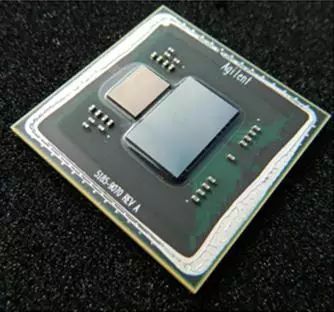
Off-chip stitching refers to the stitching of multiple ADC chips on a PCB. A typical example of off-chip stitching is the Keysight Z series oscilloscopes, which achieve a sampling rate of 160G/s by stitching together 8 chips with a 20G/s sampling rate ADC, ensuring a hardware bandwidth of up to 63GHz. Off-chip stitching requires excellent consistency in bias and gain between chips, and precise control of signal and sampling clock delays on the PCB. Therefore, the front-end chips of the Z series oscilloscopes employ a sample-and-hold technique before signal distribution and analog-to-digital conversion, greatly improving the margin for PCB trace errors and jitter.
3. Typical Applications of Broadband Oscilloscopes in RF Signal Testing
Thanks to the rapid enhancement of bandwidth and sampling rate brought about by chip, material, and process technologies, broadband real-time oscilloscopes have begun to play a key role in RF signal testing. Below are some typical applications.
Comprehensive Time-Frequency Domain Analysis of RF Signals
The performance improvements of real-time oscilloscopes allow their bandwidth to directly cover RF, microwave, and even millimeter-wave frequency bands, enabling direct capture of the time-domain waveform of the signal carrier for analysis. This allows for clear observation of the pulse envelope of the signal and the time-domain waveform of the carrier signal within the pulse, making time-domain parameter testing more straightforward and intuitive. Since there is no need to down-convert the signal before sampling, the testing system is also simpler, avoiding additional signal distortion caused by suboptimal down-converter performance.
Furthermore, the time-gate function of the oscilloscope can be used to amplify or perform FFT transformations on a specific region of an RF signal. The figure below shows the results of FFT transformations performed on two different time windows selected from a segment of an RF pulse, clearly illustrating the changes in the signal spectrum within different time window ranges.
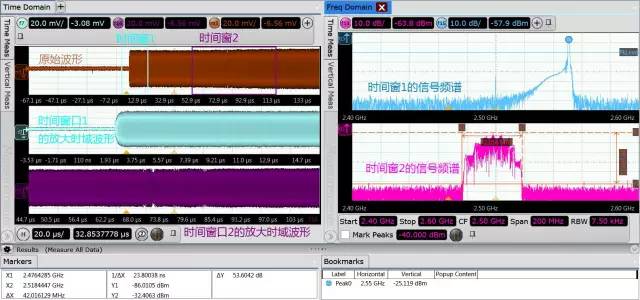
Radar Pulse Parameter Testing
For radar and other pulse-modulated signals, parameters such as pulse width, rise time, duty cycle, and repetition frequency are critical time-domain parameters. According to the IEEE Std 181 specification, the definitions of some key pulse parameters are illustrated in the figure below.
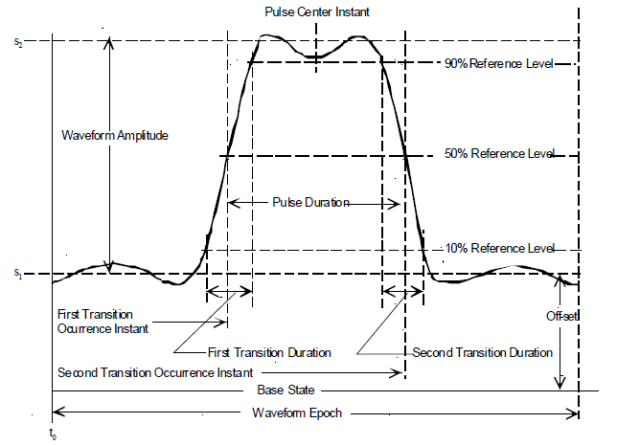
Once the RF pulse has been captured using a broadband oscilloscope, a mathematical detector can be created using the built-in mathematical functions of the oscilloscope. The black curve in the figure below represents the envelope signal extracted from the original signal using the mathematical detector. After obtaining the envelope waveform, basic pulse parameter testing can be performed using the oscilloscope’s measurement functions.
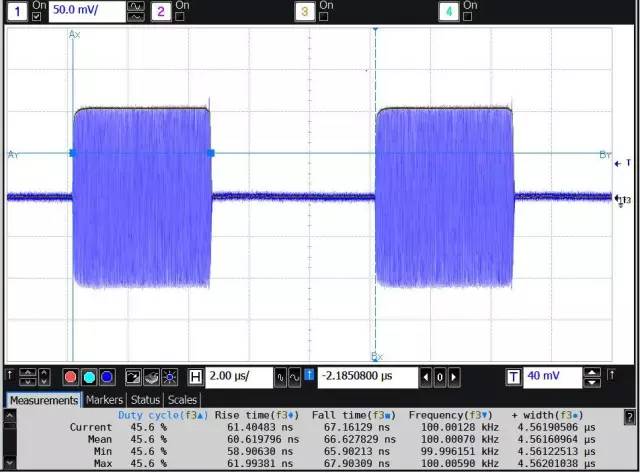
Moreover, we can also utilize the oscilloscope’s FFT function to obtain the frequency spectrum distribution of the signal, and use the oscilloscope’s jitter analysis software to obtain the waveform of the frequency or phase changes of the internal signal over time, displaying these results together. The figure below shows the time-domain waveform, frequency/phase change waveform, and frequency spectrum results of a Chirp radar pulse. Through the comprehensive display and analysis of these waveforms, the changing characteristics of the radar signal can be intuitively observed, allowing for simple parameter measurements.
In testing radar and other pulse signals, the ability to capture a sufficient number of continuous pulses for statistical analysis is also crucial. For instance, if a search radar has a pulse repetition period of 5ms, capturing 1000 continuous pulses would require recording data for 5s. If the oscilloscope used has a sampling rate of 80G/s, the required memory depth for recording 5s of data would be =80G/s*5s=400G samples, which is nearly impossible to achieve.
To address this issue, modern high-bandwidth oscilloscopes support segmented memory modes. The so-called segmented memory mode refers to dividing the continuous memory space of the oscilloscope into many segments, where each time a trigger occurs, only a short time of data is collected until enough segments have been recorded. Many radar pulses are narrow, and when testing the performance of radar transmitters, if only the signal during the short time of pulse transmission is of interest, using segmented memory can more effectively utilize the oscilloscope’s memory.
In the example shown below, the width of the pulse being measured is 1us, and the repetition period is 5ms. We use the segmented memory mode on the oscilloscope, setting the sampling rate to 80G/s, allocating 200k points of memory for each segment, and setting it to record 10000 segments continuously. Thus, the time length that can be recorded for each segment is =200k/80G=2.5us, and the total memory depth used by the oscilloscope is =200k points * 10000 segments = 2G points, achieving a recording time of =5ms*10000=50s. In other words, the segmented memory mode allows for the continuous recording of 10000 radar pulses over a total of 50s.
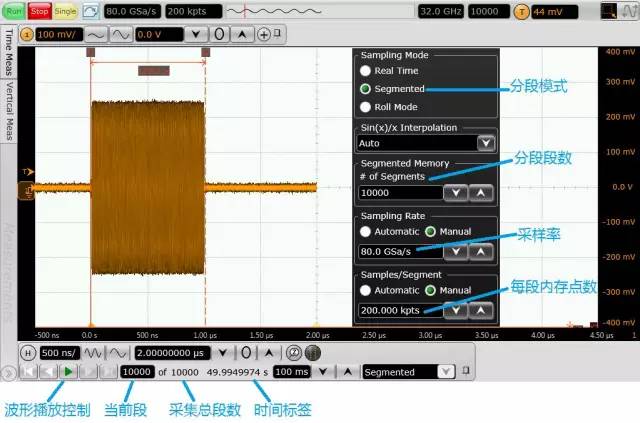
Comprehensive Analysis of Radar Parameters
In addition to directly measuring the basic parameters of radar pulses on the oscilloscope, more powerful vector signal analysis software can also be utilized. The figure below shows an example of demodulation analysis of ultra-wideband Chirp radar signals using the Keysight 89601B vector signal analysis software in conjunction with the oscilloscope. The figure displays the frequency spectrum, time-domain power envelope, and frequency variation over time of the measured signal. The measured signal is generated by the M8195A ultra-wideband arbitrary waveform generator, with a Chirp signal pulse width of 2us and a frequency variation range from 1GHz~19GHz, resulting in an overall signal bandwidth of up to 18GHz! This fully demonstrates the advantages of real-time oscilloscope bandwidth.
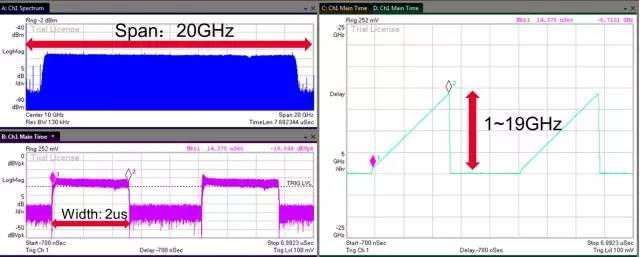
More stringent radar testing does not only measure basic parameters such as pulse and modulation bandwidth. For instance, due to insufficient bandwidth of components or suboptimal frequency response characteristics, variations in power of various frequency components within the Chirp pulse may occur, leading to droop and ripple phenomena on the pulse power envelope. Therefore, strict radar performance metrics testing also requires measuring parameters such as peak power, average power, peak-to-average ratio, droop, ripple, frequency variation range, linearity, and the frequency and phase variations between multiple pulses, or analyzing the time-varying curves and histogram distributions of these parameters. These more complex tests can be implemented using the BHQ radar pulse measurement option in the 89601B software. This testing software also supports the segmented memory mode of the oscilloscope, allowing for the capture of multiple continuous pulses for statistical analysis. The figure below shows an example of an actual test.
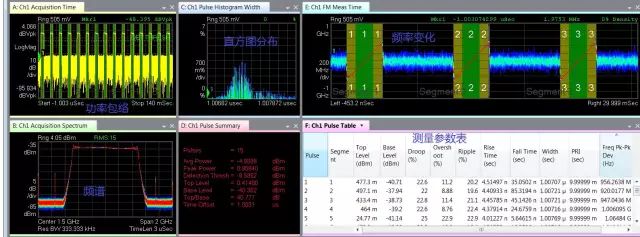
Frequency Hopping Signal Testing
In addition to radar pulse analysis, the oscilloscope’s jitter analysis software or vector signal analysis software can also be used to analyze ultra-wideband frequency-modulated signals. The figure below shows the frequency spectrum, time domain, and frequency modulation pattern analysis results of a signal modulated within a bandwidth range of 7GHz.
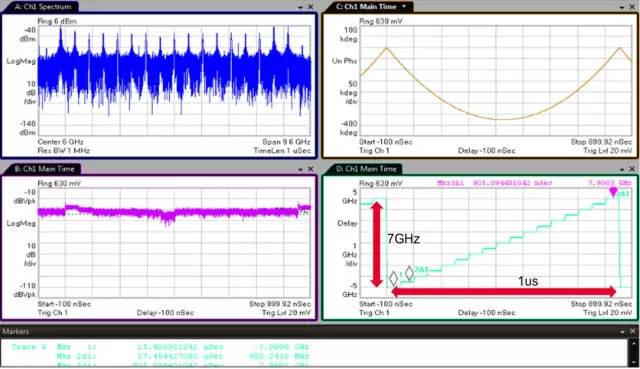
Modulator Delay Testing
In satellite communication or navigation fields, it is necessary to test the absolute delay of RF output (which may be RF or Ku/Ka band signals) relative to internal timing signals (1pps or 100pps signals) and make corrections. This requires using at least a 2-channel broadband oscilloscope to simultaneously capture the timing signal and RF output, allowing for precise and repeatable measurements.
The figure below shows the timing signal (blue waveform) and QPSK modulated RF output signal (purple waveform) captured by the oscilloscope. The timing of the first zero crossing of the RF signal relative to the timing signal is the system delay to be measured. If only manual cursor measurements are used, it is difficult to accurately pinpoint the appropriate power zero crossing position. By utilizing the previously mentioned digital detection function, the power envelope of the RF signal can be extracted and amplified (as shown by the gray waveform), and the oscilloscope’s measurement functions can be used to measure the time of the minimum point of the power envelope (Tmin), achieving precise testing of the delay of satellite transponders or modulators. Through multiple automatic tests of the zero crossing timing, long-term statistics can also be performed to analyze the range of delay variations and jitter.
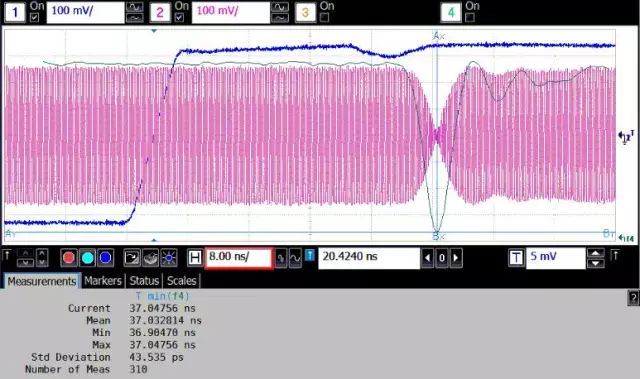
Demodulation Analysis of Broadband Communication Signals
In WLAN, satellite communication, and optical communication fields, performance testing and demodulation analysis of very high bandwidth signals (>500MHz) may be required, which places high demands on the bandwidth and channel count of measuring instruments. For example, in optical fiber backbone transmission networks, single-wavelength signal transmission of 100Gbps has been achieved, utilizing technology that modulates two 25Gbps signals onto a laser’s polarization state via QPSK modulation, and then combines another two 25Gbps signals in the same manner to achieve 100Gbps signal transmission. In the development of next-generation 200Gbps or 400Gbps technologies, higher baud rates and higher-order modulations such as 16QAM, 64QAM, or even OFDM may be employed, all of which impose very high requirements on the bandwidth and performance of measuring instruments.
The figure below shows the Keysight 100G/400G optical coherent communication analyzer N4391A: the lower half of the instrument is a coherent optical communication demodulator used to decompose the input signal’s four I/Q signals under two polarization states into electrical signals, with each channel supporting a maximum signal baud rate of up to 126Gbaud; the upper half is a high-bandwidth Z series oscilloscope, which can achieve a measurement bandwidth of four channels at 33GHz or two channels at 63GHz; the oscilloscope runs the 89601B vector signal analysis software, which can complete polarization alignment, dispersion compensation, and simultaneous demodulation and display of four I/Q signals.
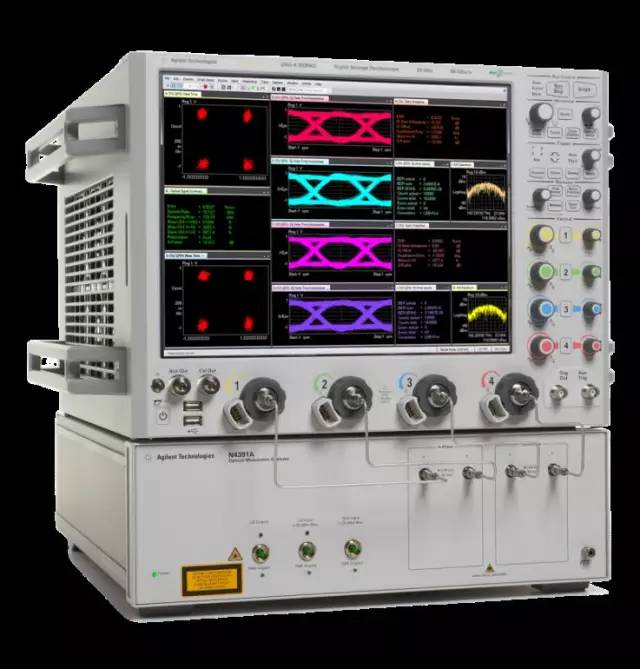
The figure below also shows the results of demodulation analysis of ultra-wideband signals performed using the oscilloscope, with the measured signal being a M8195A generated 32Gbaud 16QAM modulated signal. Since each symbol in the 16QAM modulation format can transmit four bits of effective data, the actual data transmission rate reaches 128Gbps. Through broadband frequency response correction and pre-distortion compensation, a signal-to-noise ratio of over 20dB and an EVM (Error Vector Magnitude) of less than 4% were achieved.
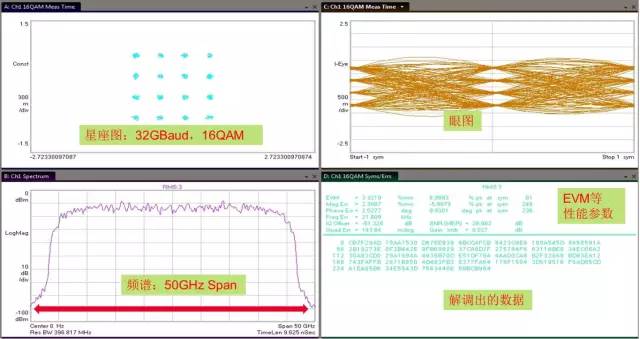
Multi-Channel Measurement
In MIMO (Multiple-input and Multiple-output), phased array, and scientific research scenarios, simultaneous measurement of more than four high-speed signals is often required. To meet this application, modern high-bandwidth oscilloscopes provide support for multi-channel measurements in both hardware and software. Keysight‘s N8834A multi-channel oscilloscope software supports multi-channel oscilloscope solutions from the Infiniium 9000, 90000, S, V, and Z series.
The figure below illustrates a multi-channel cascading solution based on the Z series oscilloscope and the multi-channel measurement software within the oscilloscope, which currently supports cascading up to ten oscilloscopes, providing 20 channels with a synchronous bandwidth of up to 63GHz, or 40 channels with a bandwidth of 33GHz. Through precise delay and jitter calibration, inter-channel jitter can be controlled within 150fs (rms).
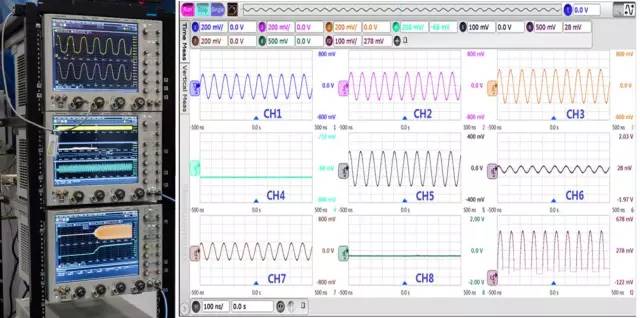
EMI/EMC Pre-Testing Functionality
Many RF products must comply with EMC regulations, and EMI phenomena also affect product performance, especially in terms of noise and jitter. If not carefully managed, they can disrupt the functionality of the entire circuit. Therefore, many circuit design guidelines include protective frequency bands, reference ground planes, loops, power control feedback, and spread spectrum clocks, all aimed at minimizing EMI effects.
Common causes of EMI issues include switching power supplies, power filtering, ground impedance, LCD screens, static electricity from metal shielding enclosures, poor cable shielding, internal coupling of routing paths, parasitic parameters of components, and incomplete signal loops.Common analysis methods for EMI issues involve using spectrum analyzers. However, many engineers may not be aware that oscilloscopes can also be used for EMI pre-testing. Previously, a concern was that oscilloscopes mostly used 8-bit ADCs, which have poor amplitude and phase frequency response. However, with the introduction of the Infiniium S series oscilloscopes, which use 10-bit ADCs in the 500MHz to 8GHz bandwidth range, and the V series, which reduces the noise floor significantly in the 8GHz to 33GHz bandwidth range, oscilloscopes have gained many functionalities for EMI pre-testing, including frequency domain templates, near-field probes, simultaneous analysis of up to eight FFTs, arbitrary position triggering, and simultaneous analysis of analog, digital, and serial signals.
The figure below shows examples of near-field probes and frequency domain template triggering that can be used for EMI pre-testing.
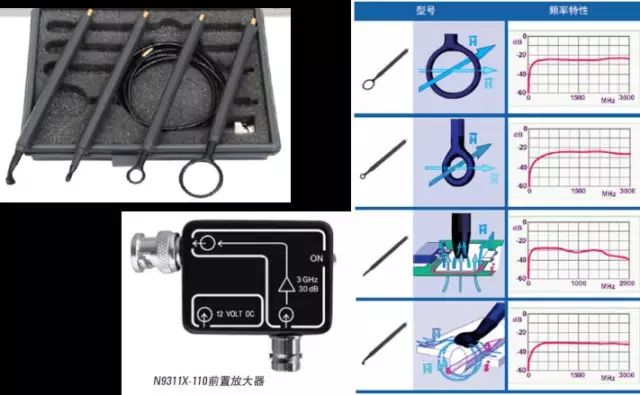
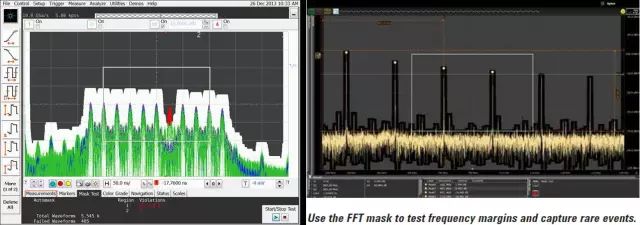
4. RF Performance Indicators of Oscilloscopes
From the typical applications of oscilloscopes in RF testing introduced earlier, it is evident that due to technological advancements, the high bandwidth and multi-channel advantages of oscilloscopes are very suitable for various complex ultra-wideband applications, while their time-domain and frequency-domain comprehensive analysis capabilities have also improved measurement intuitiveness.
However, when using oscilloscopes for RF signal testing, we cannot overlook certain concerns regarding their accuracy and performance. Although real-time oscilloscopes have high sampling rates, they generally use 8-bit ADCs, resulting in larger quantization errors and noise floors. Moreover, traditional oscilloscopes only provide bandwidth, sampling rate, and storage depth indicators, with few performance indicators available for reference in the frequency domain. Therefore, we will analyze some actual tests to understand the RF performance indicators of oscilloscopes.
Noise Floor
The noise floor is a very important indicator for measuring instruments, as it affects the signal-to-noise ratio of measurement results and the ability to measure small signals. Traditionally, oscilloscopes are considered to have high noise floors, making them unsuitable for small signal measurements; however, this is not entirely accurate, as the main reason lies in the different definitions of noise floor by different instruments.
The primary sources of noise floor are thermal noise and noise added by the front-end amplifier, both of which are typically approximately proportional to bandwidth. For example, the calculation formula for thermal noise shows that noise power is linearly related to bandwidth.
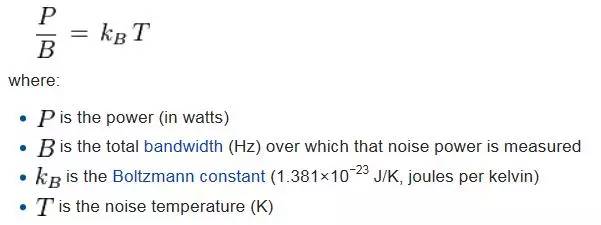
As a broadband measuring instrument, the noise floor indicator of an oscilloscope represents the total noise across the entire bandwidth range and is also approximately proportional to bandwidth.
For instance, the left side of the figure below shows the noise floor indicators provided in the manual of the Keysight S series oscilloscopes. At a range of 50mv/div, the noise floor of the S-404 oscilloscope with a bandwidth of 4GHz is 768uVrms, which is approximately double that of the S-104 oscilloscope with a bandwidth of 1GHz at the same range, which has a noise floor of 456uVrms. Since power is the square of voltage, the noise power of the 4GHz oscilloscope is four times that of the 1GHz oscilloscope under the same conditions, corresponding to the ratio of bandwidth.

Because the noise floor is approximately proportional to bandwidth, the noise floor of broadband oscilloscopes will be larger than that of narrowband oscilloscopes. To make a fair comparison, we can normalize the noise floor of oscilloscopes at different ranges to per unit Hz, which is also the method used to describe the noise floor (DANL) in RF instruments such as spectrum analyzers.
For example, at a range of 50mv, the full scale of the oscilloscope is 8 divisions, equivalent to 400mV, corresponding to a full scale of -4dBm. For the S-804A oscilloscope with an 8GHz bandwidth, the total noise floor within the 8GHz bandwidth is 1.4mVrms, equivalent to -44dBm, and when normalized to per unit Hz, the noise floor is approximately -143dBm/Hz. In smaller ranges, the noise floor of the S series oscilloscopes can reach -158dBm/Hz, which is better than the vast majority of spectrum analyzers when the preamplifier is not turned on. Even when the preamplifier is turned on, many spectrum analyzers’ DANL indicators are only a few dB better than those of the S series oscilloscopes.
The figure below shows the measured results of the noise floor of an S series 8GHz bandwidth oscilloscope at the minimum range. The center frequency is 1GHz, Span=20MHz, and aside from a small spurious at the 1GHz frequency point, the noise floor at RBW=10KHz is approximately -120dBm, equivalent to about -160dBm/Hz.
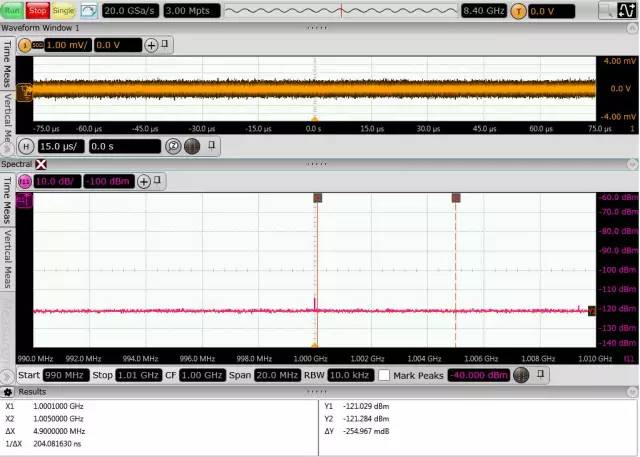
Therefore, after normalizing to per unit Hz, the noise floor of the oscilloscope has already surpassed that of the vast majority of spectrum analyzers when the preamplifier is not turned on, which is quite a good indicator.
Since noise is proportional to bandwidth, if the signal bandwidth is concentrated within a specific frequency range, unnecessary out-of-band noise can be filtered out using corresponding digital filtering techniques to improve the signal-to-noise ratio. For instance, many oscilloscopes have digital bandwidth adjustment functions that serve as a method to reduce the oscilloscope’s own noise floor.
Spurious-Free Dynamic Range (SFDR)
In RF testing, in addition to the noise floor, the spurious-free dynamic range (SFDR) is also very important, as it determines the minimum signal energy that can be distinguished in the presence of large signals. For oscilloscopes, the main source of spurious is due to imperfections in ADC stitching. For example, in the case of two ADCs stitched together, if the phase of the sampling clock is not controlled precisely to 180 degrees, it may cause signal distortion, resulting in spurious signals appearing in the spectrum with a frequency equal to the stitching frequency. If the distortion is severe, even the highest sampling rates cannot guarantee the authenticity of the captured signal.
For high-bandwidth oscilloscopes, whether using on-chip or off-chip stitching, the spurious caused by imperfect stitching is objectively present, and the key factor is the magnitude of the spurious energy. Taking the Keysight S series oscilloscopes as an example, they use a single-chip 40G/s ADC, with clock distribution and sample-and-hold circuits optimized through specialized processes to ensure good consistency. The figure below shows the spectrum observed at 5GHz after filtering harmonics from a 1GHz signal generated by the Keysight E8267D signal source, where aside from the second and third harmonic distortions, the spurious indicators can reach -75dBc, comparable to the level of a mid-range spectrum analyzer.
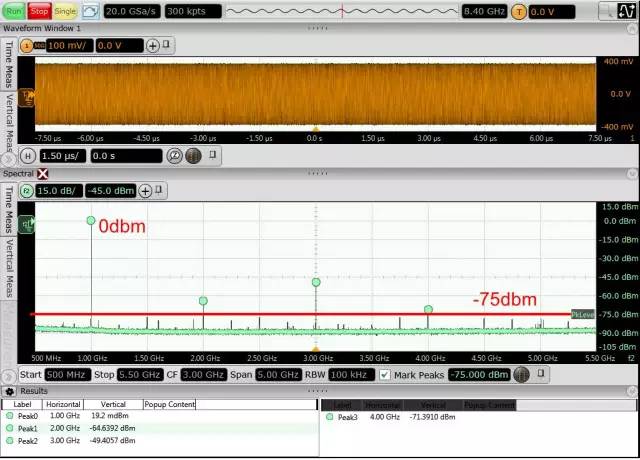
Harmonic Distortion
Harmonic distortion is also an important indicator for measuring the fidelity of the measured signal. For oscilloscopes, to ensure high sampling rates, the bit depth of the ADC (8-bit or 10-bit) differs significantly from the 14-bit ADCs used in spectrum analyzers. The harmonic distortion primarily arises from quantization noise of the ADC, typically the second and third harmonic distortions, with the third harmonic often having greater energy, which differs from the second harmonic distortion caused by mixers in spectrum analyzers.
In the previous test results, the second harmonic distortion was approximately -65dBc, which is somewhat worse than that of typical spectrum analyzers. The third harmonic distortion was approximately -49dBc, which is significantly worse than that of typical spectrum analyzers. Therefore, if users are concerned about harmonic distortion metrics, such as in nonlinear testing of amplifiers, using oscilloscopes may not be a good choice.
Fortunately, harmonic-induced distortion typically occurs out of band, and can be easily filtered out through simple mathematical filtering. Thus, in some applications of broadband signal demodulation, the impact of harmonic distortion on the final demodulation results is not significant due to the measurement algorithms incorporating mathematical filters during the demodulation process.
Absolute Amplitude Accuracy
Absolute amplitude accuracy affects the accuracy of the oscilloscope when measuring the power of a carrier at a specific frequency. For oscilloscopes, the absolute amplitude accuracy indicator is defined as DC amplitude measurement accuracy + amplitude-frequency response. Therefore, both parts need to be analyzed separately.
The DC amplitude measurement accuracy is the nominal dual-cursor measurement accuracy of the oscilloscope, which consists of DC gain error and vertical resolution (as shown in the figure below, which presents the DC measurement accuracy indicators of the Keysight S series oscilloscopes). For real-time oscilloscopes, the DC gain accuracy is generally around 2% of full scale, while the resolution is related to the bit depth of the ADC used; for a 10-bit ADC, it is equivalent to 1/1024 of full scale. Thus, the absolute amplitude accuracy of real-time oscilloscopes is approximately ±0.2dB.

As for amplitude-frequency response, traditionally, the amplitude-frequency response of broadband devices is not particularly good, but modern high-performance oscilloscopes are calibrated and compensated for frequency response at the factory, resulting in very flat amplitude-frequency response curves. The figure below shows the amplitude-frequency response curve of the Keysight S series oscilloscope with an 8GHz bandwidth, indicating that its in-band flatness is very good, with fluctuations not exceeding ±0.5dB within 7.5GHz.
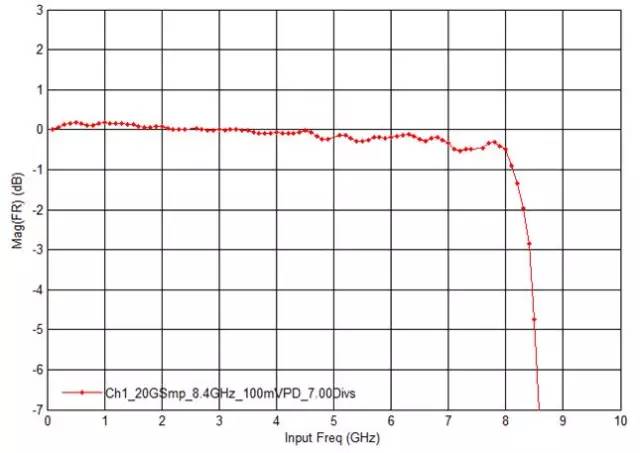
Therefore, overall, the absolute amplitude measurement accuracy of the S series oscilloscopes can be controlled within ±1dB within the range of 7.5GHz, which is comparable to the indicators of most mid-range and high-end spectrum analyzers. The Keysight V series oscilloscopes can even guarantee an absolute amplitude accuracy of ±0.5dB within the range of 30GHz, exceeding the indicators of most high-end spectrum analyzers.
Phase Noise
The phase noise of measuring instruments reflects the magnitude of near-end low-frequency noise when testing a pure sine wave, which affects the ability to identify slow target Doppler frequency shifts in applications such as radar. The frequency domain integration of phase noise corresponds to jitter in the time domain. For oscilloscopes, poor phase noise or excessive jitter can introduce additional noise during RF signal sampling, degrading effective bits.
Traditional oscilloscopes did not focus much on sampling clock jitter or phase noise, but with the increasing sampling rates of oscilloscopes and the need to improve RF testing performance, modern digital oscilloscopes such as the Keysight S, V, and Z series have optimized their clock circuits, even adopting classic microwave signal source designs like those in the E8267D, significantly improving the phase noise indicators of oscilloscopes. The figure below shows the phase noise curve of the S oscilloscope at a carrier frequency of 1GHz, with the RBW set to 750Hz, where the noise energy at a deviation of 100kHz from the center carrier is approximately -92dBm, normalized to per unit Hz energy of approximately -120dBc/Hz, which exceeds the phase noise indicators of most mid-range spectrum analyzers. The higher-performance V series oscilloscopes can achieve phase noise indicators of approximately -130dBc/Hz@100KHz offset, surpassing the corresponding indicators of most mid-range and high-end spectrum analyzers.
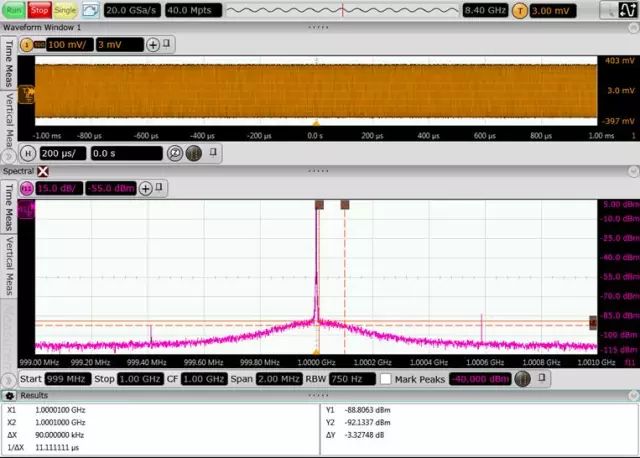
5. Conclusion
From the previous discussions, it is evident that modern high-performance real-time oscilloscopes, aside from the significant harmonic distortion indicators caused by the limitations of ADC bit depth, have spurious-free dynamic ranges comparable to mid-range spectrum analyzers, while their noise floor, in-band flatness, absolute amplitude accuracy, and phase noise indicators can be similar to those of mid-range and high-end spectrum analyzers.
Moreover, to meet the requirements of RF testing, modern high-performance oscilloscopes not only provide traditional time-domain indicators but also begin to specify RF indicators to adapt to the usage habits of RF users. The table below presents typical RF indicators provided in the Keysight V series oscilloscopes.
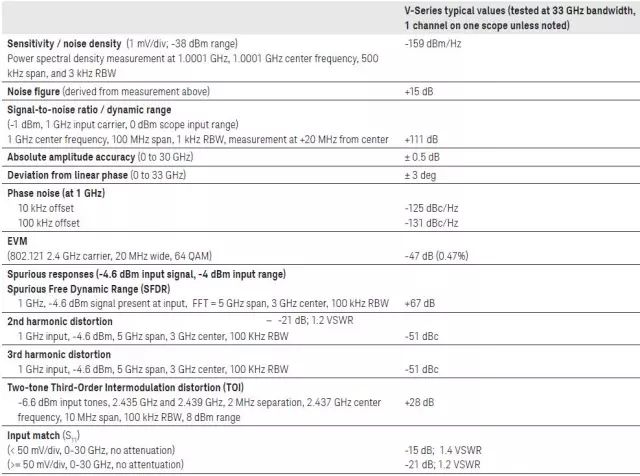
Of course, due to differences in working principles, real-time oscilloscopes still have some limitations when performing frequency domain analysis, such as under particularly small RBW settings (<1KHz), where the need to collect large amounts of data for FFT calculations can severely slow down waveform update speeds, making them unsuitable for narrowband signal measurements.
It is precisely because of the significant high bandwidth, multi-channel advantages, and powerful time-domain measurement capabilities of real-time oscilloscopes, combined with improved RF performance indicators, that they are beginning to play an increasingly important role in the measurement of ultra-wideband RF signals, comprehensive time-frequency domain analysis, and multi-channel measurements.
Author’s Biography:
Li Kai, graduated from the Department of Optoelectronic Engineering at Beijing Institute of Technology with a master’s degree, has 15 years of experience in the communication and measurement industry. He joined Agilent Technologies in 2006, responsible for applications and research of high-speed digital testing products such as signal integrity analysis. He is the author of the book “Principles and Testing Guide for High-Speed Digital Interfaces” and has published numerous articles on high-speed bus measurement principles and methods in magazines such as “Foreign Electronic Measurement Technology,” “Electronic Engineering Magazine,” and on his personal technical blog on EDN China.

WeChat Group for Thousands
1. Limited to RF, no duplicate group joining
2. Add the group owner first, and invite to join after verification
3. Please indicate: unit + position/direction

RF Baohua Tan
Follow the largest RF public account in China

RF Baohua Tan
Focus on sharing and disseminating RF microwave/high-frequency technology. Founded by senior RF experts, director of the RF laboratory at Xingsen Technology, and editor of “ADS2008/2011 RF Circuit Design and Simulation Examples” and “HFSS RF Simulation Design Examples Collection”. This account has attracted 50,000 followers and over 10,000 group members (with over 2,000 PhDs). The WeChat group gathers global Chinese RF elites, pooling the experience and wisdom of industry masters, answering questions, and sharing insights. The group includes many general managers, chief engineers, directors, technical directors, professors, Thousand Talents Program members, Changjiang Scholars, chief scientists, IEEE Fellows, etc.